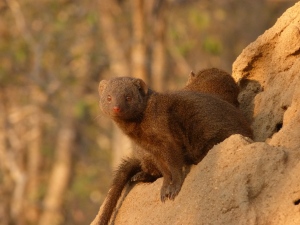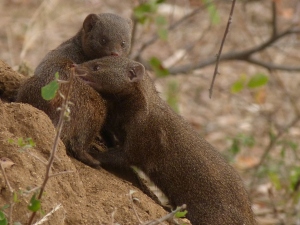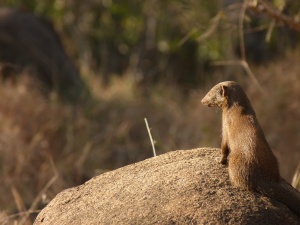SA Animal Profile – The Dwarf Mongoose (an introduction)
If you’ve been reading my blog posts, you will hopefully have noticed that the common thread, or my current raison d’être, is a particularly lovely species, the Dwarf Mongoose (Helogale parvula). Similar looking to a mustelid, such as the UK weasel or stoat, this small (hence the name) animal is one of a range of mongoose species, and is found in the southern savanna and parts of the south west of the African continent. In the Limpopo Province of South Africa (where I’m located), they are a fairly common animal.
Dwarf mongoose (Helogale parvula)
The dwarf mongoose is beautiful creature – slim, glossy-coated and fascinating. A highly sociable animal, they live in groups consisting of a dominant alpha pair, their offspring and other subordinate adults. The dominant male and female are the only ones to breed, producing an average litter size of three pups. All adults contribute to the care of the offspring – babysitting, warming and transporting them. Additionally, other females may lactate to feed the pups, despite not breeding themselves.
Each group has a territory, which may overlap between adjacent groups and cause hostility. If two packs do meet, the smaller group usually avoids the larger one. Within the range of their territory, the mongoose have a network of sleeping burrows, day refuges and latrines. The former are normally termite mounds, although trees are also used.
A standard day for a dwarf mongoose starts quite casually. Upon getting up from the sleeping burrow, the group usually spend some time sunbathing and grooming. The amount of time can vary from group to group, and from day to day. When they’re ready, they leave the sleeping burrow for a day of foraging.
Mutual grooming at a refuge
The diet of a dwarf mongoose typically consists of insects such as grasshoppers, beetles, and larvae, though small vertebrates may also be taken. Foraging occurs in grass, through leaf litter and around logs and trees. As they often need to dig for food, dwarf mongoose are vulnerable to predators including birds of prey, jackals and snakes. While an individual will often pause foraging to scan for predators, they cannot be vigilant during the actual digging process. One mongoose may act as a sentinel, where it sits in a prominent position such as on a rock or log and will alarm call if a threat appears. A sentinel is posted for about 40% of foraging time.
Sentinal mongoose on a rock
The end of the day is reverse to the beginning. The dwarf mongoose will return to their sleeping burrow at some point in the few hours of sunset (it can be two hours before, or less than half hour before), either the same burrow as the morning or a different one within their territory. They normally spend some time sunbathing and grooming before heading down to sleep.
There are many aspects of their behaviour that I haven’t covered, but this has been only a general overview and introduction to the dwarf mongoose species.




Leave a Reply
Want to join the discussion?Feel free to contribute!